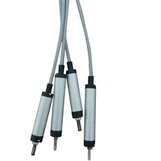Dynisco Melt Pressure Transducer

Features
● High precision, can replace similar imported products
● Full stainless steel package
● Easy to install
● 80% internal calibration
● Good stability and repeatability
|
Pressure range |
0~150Mpa |
|
Accuracy |
0.25%FS; 0.5%FS; 1%FS |
|
Repeatability |
0.05% FS |
|
Non linear |
0.2%FS; 0.5%FS |
|
Output signal |
2m V/V; 3.3m V/V;4-20Ma; 0-5V;0-10V |
|
Output impedance |
350/1000/1500/2000Ω |
|
Voltage |
10VDC(sensor) 24VDC (transmitter) |
|
Operating temperature |
-20~80℃ |
|
Compensation temperature |
-10~60℃ |
|
Overload pressure |
Safe overload 120%FS, ultimate overload 150%FS |
|
Medium materials |
Pressure fittings are stainless steel |
|
Pressure connection |
G1/2,1/2-20UNF,M14*1.5, M20*1.5 Ect |
|
Reponse time |
<5ms |


Meltblown Fabrics, Non-Woven Fabrics, Chemical Fiber Drawing Equipment
Monitors real-time pressure in extruders and spinnerets to ensure stable fiber formation.
Prevents defects in meltblown and spunbond non-woven production.
Plastic & Rubber Manufacturing Equipment
Used in extruders, injection molding, and blow molding machines for precise pressure control.
Ensures product consistency and reduces material waste.
Medical, Food Processing, and Packaging Equipment
Maintains hygienic high-pressure conditions in medical film and food packaging production.
Ensures safety and compliance in sterile processing.
High-Temperature Fluid Pressure Monitoring
Tracks pressure in chemical reactors, oil refining, and other high-viscosity fluid systems.
Enhances process stability and equipment safety.
These sensors improve efficiency, quality, and safety in high-temperature industrial processes.
Importance of Melt Pressure Transducers in Extrusion Lines
Melt pressure transducers are critical components in extrusion processes, ensuring product quality, process stability, and equipment safety. They measure the real-time pressure of molten material (e.g., plastic, rubber, or food compounds) within the extruder barrel or die, enabling precise control and optimization. Below are their key roles and benefits:
Process Control & Consistency
- Function: Monitor pressure fluctuations to maintain uniform material flow.
- Impact: Prevents defects like variations in thickness, bubbles, or weak spots in extruded profiles (e.g., pipes, films, cables).
- Example: In plastic extrusion, stable pressure ensures consistent wall thickness.
01
Equipment Protection
- Function: Detect excessive pressure that could damage the extruder screw, barrel, or die.
- Impact: Triggers alarms or shutdowns to avoid catastrophic failures (e.g., burst pipes, screw breakage).
- Example: Prevents overpressure in PVC extrusion, which can degrade material and harm machinery.
02
Energy Efficiency & Cost Savings
- Function: Optimize extrusion speed and heating zones based on pressure data.
- Impact: Reduces energy waste and material scrap, lowering production costs.
- Example: Adjusts screw RPM in aluminum extrusion to minimize power consumption.
03
Quality Assurance
- Function: Ensure compliance with industry standards (e.g., ISO, ASTM) by logging pressure trends.
- Impact: Guarantees product reliability for critical applications (e.g., medical tubing, automotive seals).
04
Advanced Process Monitoring
- Integration: Pair with temperature sensors and PLC systems for closed-loop control.
- Technology: Modern transducers offer digital outputs (IO-Link, CANbus) for Industry 4.0 automation.
05

How To Install The Pressure Sensor ?
The diaphragm of the pressure sensor is the most vulnerable part. Please do not remove its protective cap at will before installation. At the same time, pay attention to protecting the diaphragm of the pressure transmitter during installation. The processing of the mounting hole should be processed according to the technical requirements of the mounting hole dimension drawing and dimension table to avoid diaphragm scratches caused by non-standard mounting holes that affect the normal operation of the pressure transmitter.
Removal of pressure sensor
During installation, make sure there is no metal foreign matter or plastic left in the installation hole. All pressure transmitters should be removed from the machine before cleaning the extruder. The pressure transmitter can only be removed when the polymer is in a hot molten state. After removal, immediately wipe the pressure transmitter probe diaphragm with a soft cloth. At the same time, Xiaogan Yueneng Electronic Technology Co., Ltd. can provide special cleaning tools for the installation hole to clean the material remaining in the hole to facilitate the next installation.
About startup
Before starting the equipment, sufficient heating and melting time must be ensured to ensure that all materials in the diaphragm part of the pressure transmitter are in a molten state before the extruder works.

why choose us ?
competitive price
We offer high-quality products at factory-direct prices, saving you cost without compromising quality.
long warranty
Our products come with an extended warranty (12 months), ensuring reliability and long-term satisfaction.
24H Online Service
Our support team is available 24/7 to assist with inquiries, orders, or after-sales service.
Global Shipping
We ship worldwide with fast and secure logistics, delivering to your doorstep efficiently.
FAQ
Q: what is the lead time ?
A: Normally the lead time is about 7-15 days.
Q: How can you arrange delivery ?
A: For small quantity , we can send by air express ,such as DHL, UPS, Fedex . For big quantity , we can arrange delivery by sea cargo .
Q: About samples:
A: Yes, we have stock for samples.
Q: About guarantee:
A: One year for free repair.























